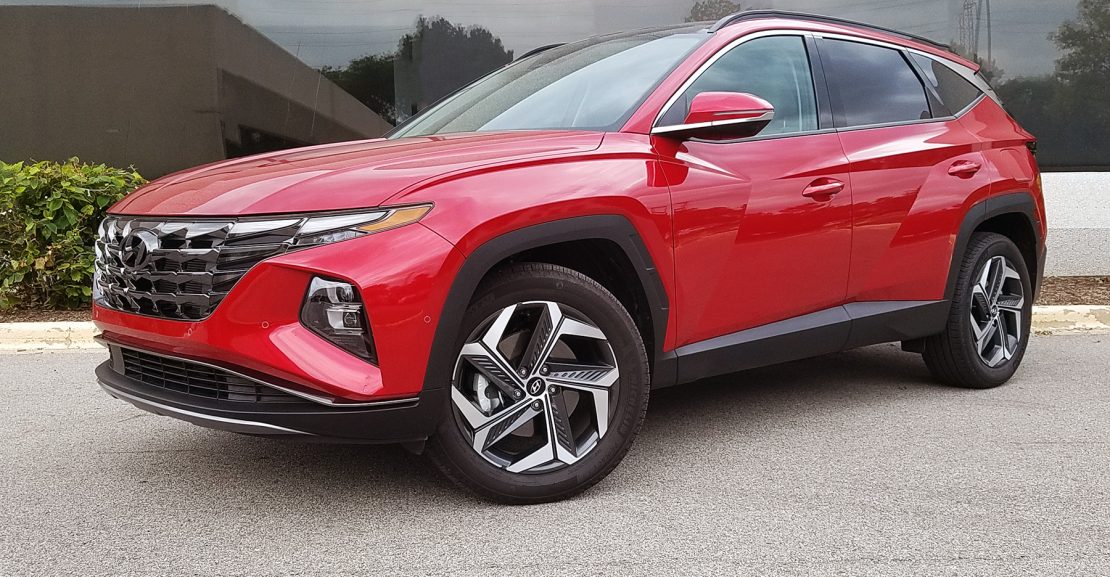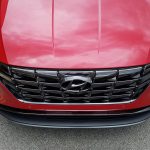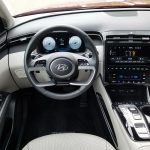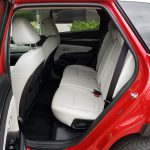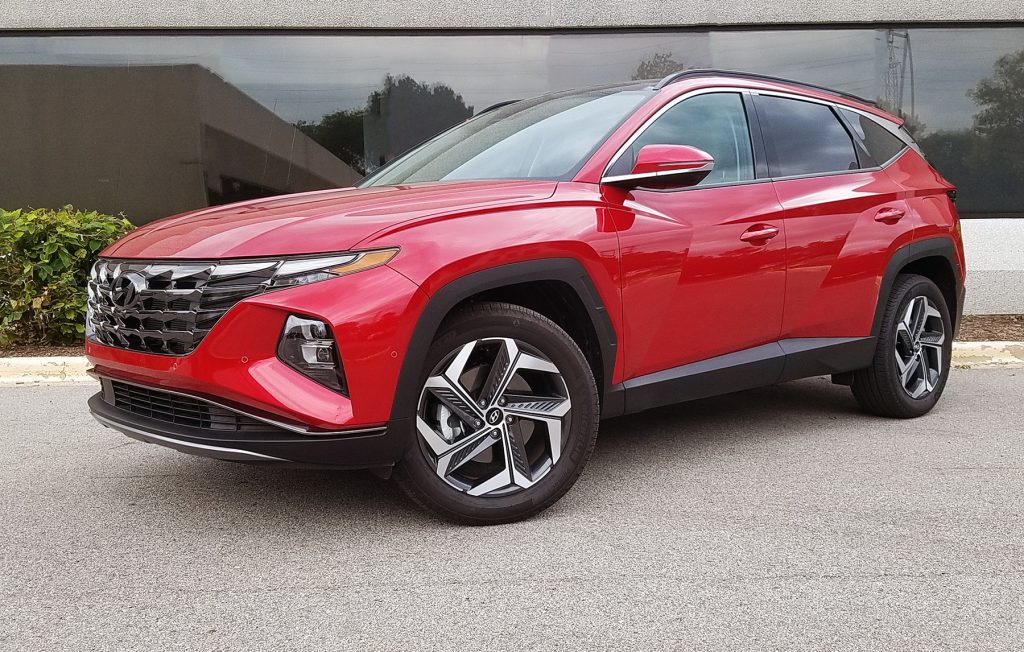
2022 Hyundai Tucson Limited AWD
Class: Compact Crossover
Miles driven: 651
Fuel used: 27.8 gallons
Real-world fuel economy: 23.4 mpg
| CG Report Card | |
|---|---|
| Room and Comfort | A- |
| Power and Performance | C+ |
| Fit and Finish | B |
| Fuel Economy | B- |
| Value | B |
| Report-card grades are derived from a consensus of test-driver evaluations. All grades are versus other vehicles in the same class. Value grade is for specific trim level evaluated, and may not reflect Consumer Guide's impressions of the entire model lineup. | |
| Big & Tall Comfort | |
| Big Guy | B+ |
| Tall Guy | A |
| Big & Tall comfort ratings are for front seats only. "Big" rating based on male tester weighing approximately 350 pounds, "Tall" rating based on 6'6"-tall male tester. | |
| Drivetrain | |
| Engine Specs | 187-hp 2.5-liter |
| Engine Type | 4-cyl |
| Transmission | 8-speed auto |
| Drive Wheels | AWD |
Driving mix: 40% city, 60% highway
EPA-estimated fuel economy: 24/29/26 (mpg city/highway/combined)
Fuel type: Regular gas
Base price: $36,100 (not including $1185 destination charge)
Options on test vehicle: Carpeted floor mats ($169)
Price as tested: $37,454
More Tucson price and availability information
Quick Hits
The great: Excellent passenger and cargo space for the class; generous level of standard equipment
The good: Pleasant ride quality; feature-rich infotainment system and digital gauge display
The not so good: Middling acceleration; our observed fuel economy fell short of EPA estimates; not all testers like touch-sensitive controls
CG Says:
The all-new fourth generation of the Hyundai Tucson, which launched late last spring as a 2022 model, gave Hyundai a much more compelling contender in the highly competitive compact SUV category. A big part of the new Tucson’s appeal is its upsized platform—it’s 6.1 inches longer overall and 3.4 inches longer in wheelbase than the previous generation model, which makes it much more competitive in terms of passenger and cargo volume with class mainstays such as the Honda CR-V and Toyota RAV4.
The powertrain menu expanded as well—a naturally aspirated 2.5-liter 4-cylinder with 187 horsepower replaced the previous-gen Tucson’s 2.0-liter and 2.4-liter fours, and both hybrid and plug-in-hybrid powertrains—the Tucson’s first—joined the lineup.
We haven’t had the opportunity to test the plug-in-hybrid Tucson yet, but we’ve had ample seat time with the excellent “regular” hybrid version—both in our Chicagoland offices and on a California vacation. (You can check out those reviews, as well as our First Spin report, for more information). And, we’ve now tested the Tucson’s base engine in our home-office environs as well.
Even though the Tucson Hybrid is a “greener” vehicle than the regular gas-engine Tucson—it’s EPA-rated at 37 mpg city/36 highway/37combined, compared to 24/29/26—it’s also more powerful. With its 226 horsepower and low-rpm boost from the electric motor, the Tucson Hybrid feels significantly peppier in both around-town and highway driving than the gasoline-only 2.5. The base engine’s acceleration is adequate all-around, but no more. Its 8-speed automatic transmission seems tuned for efficiency over pep; it moves into higher gears quickly to maintain low rpm, and is often hesitant to downshift for more power when you want to pass another vehicle or pull away from a stop quickly.
And, in this particular test, our observed fuel economy didn’t live up to the EPA estimates—we averaged just 23.4 mpg. That’s less than the EPA number of 24 mpg in city driving, and our driving mix consisted of a slight majority of highway driving.
As the top-line trim level, the Tucson Limited models come loaded with basically everything the Tucson has to offer. Among the standard features are a panoramic sunroof, heated and ventilated front seats, heated rear seats, heated steering wheel, and a surround-view camera system. The only options are accessory-type items such as carpeted floor mats, roof-rack cross rails, and a cargo net for the rear cargo area.
Pricing for the Tucson, like all new vehicles in the pandemic-affected global market, is volatile—it seems that base prices and destination charges can change on a weekly basis. However, the pricing gap between the Tucson Hybrid Limited and the non-hybrid Tucson Limited with all-wheel-drive has stayed the same: about $1100. At the lower end of the Tucson’s model roster, the base 2.5 engine is fine, but when you’re already comfortably past the $35K mark for a Limited model, another grand or so seems like a small price to pay for the superior power, fuel economy, and all-around driving character of the hybrid powertrain.

Test Drive: 2022 Hyundai Kona Limited

CES 2022: 2024 Chevrolet Equinox EV

Quick Spin: 2022 Volkswagen Tiguan SEL R-Line
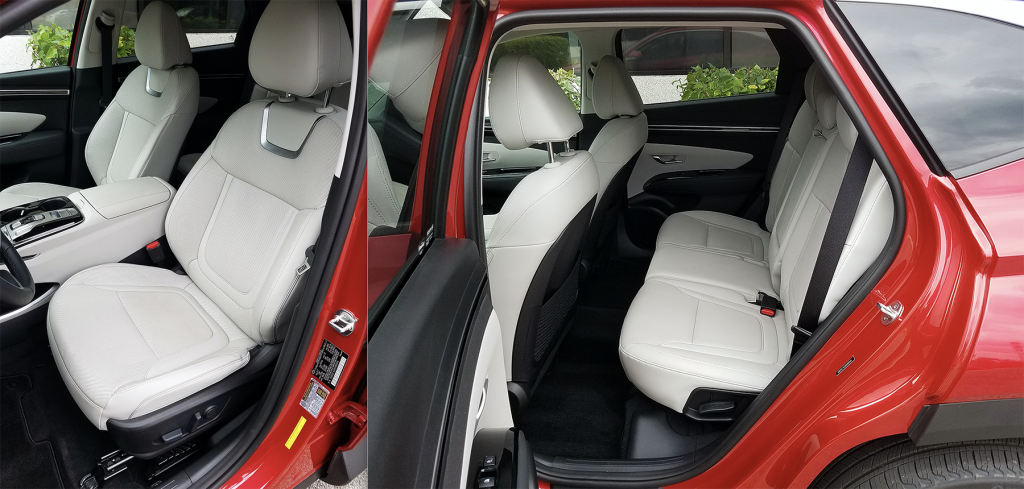
Test Drive Gallery: 2021 Toyota RAV4 Prime XSE

Test Drive: 2022 Mitsubishi Outlander SEL

Meet the 2022 Consumer Guide Best Buys


Listen to the Car Stuff Podcast
2022 Hyundai Tucson Limited Gallery
(Click below for enlarged images)

